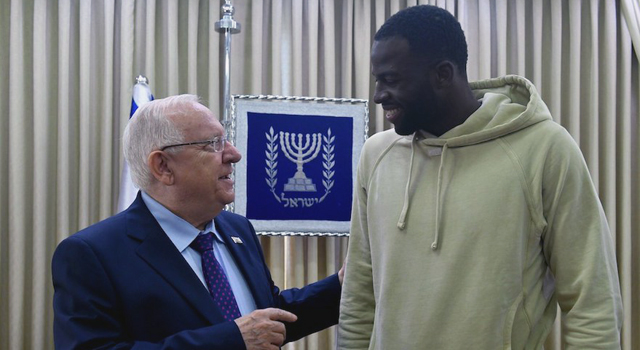By Cindy Mindell ~
WEST HARTFORD – Sometimes an invisible possession can have immeasurable and unforeseen value. This is the inspiration behind the newly published children’s book, “The Cookie That Saved My Family” (Rhyme Time Publishing, 2012), by William “Bill” Freund.
The story is based on a sequence of events from Freund’s childhood before and after World War II. He will read his book at the University of Hartford Yom Hashoah commemoration on Wednesday, April 18, from 10 a.m. to 12 noon, at the Sherman Museum of Jewish Civilization of the University of Hartford’s Maurice Greenberg Center for Judaic Studies.
William Freund and his wife, Judith, who died in 2010, have been involved in the Greenberg Center’s biblical archaeology projects since 2005. Born in Germany, Judy left with her family for British Mandate Palestine in 1933. While studying in Haifa, she developed a lifelong passion for biblical Jewish history and archeology, and eventually immigrated to the U.S., where she met Bill.
Born in Nuremberg, Germany, Bill immigrated to the U.S. with his parents and sister in 1937. He went on to create a noteworthy career in economics, retiring as chief economist for the New York Stock Exchange.
Bill and Judy took part on several archeological digs in Israel, and met Prof. Richard Freund, director of the Greenberg Center for Judaic Studies, when he lectured at a biblical archeology seminar in 2005. Their support has helped to fund several significant faculty and student excavations at sites including Bethsaide and Yavne in Israel, and the Sobibor extermination camp in Poland.
Bill and Judy had told their respective stories of escape to their children and grandchildren for decades. Last year, Bill began writing the story for his grandchildren when he realized that it might be suitable for a wider audience. Several friends, including Richard Freund, read the manuscript and encouraged him to publish it as a book, and Richard led Bill to Mollie Ostroski of Rhyme Time Publications.
“I had only done my own books but when I read his proposal, I took it on,” Ostroski says. “This is a memoir that had to be told.” Working with Minneapolis-based illustrator Toby Mikle, the book was completed three months later.
“When we discussed the appropriate audience, I suggested ages 6 to 12,” Bill says. “But after Mollie read it, she said, ‘It’s for 6 to 96. Adults will get pleasure from reading it too.’”
The story is told from a child’s perspective, following the Freund family from Germany as the Nazis were taking power, to their new lives in New York City. The family managed to escape Germany before World War II, and Bill says that he doesn’t talk a lot about the Holocaust in the book. He describes his father’s arrest and beating at the hands of the Nazis, and several illustrations depict Nazi soldiers wearing armbands with a swastika.
But the story focuses on how the family worked to rebuild their lives with seven dollars and a secret recipe, which Bill’s mother Paula had paid a neighbor and pastry chef to teach her.
“Most of the book is about how my mother took away in her head the recipe for lebkuchen,” Bill says. “The lesson for the children is that what you take away in your head can’t be taken from you.”
Invented by German monks in the 13th century, the confection is a traditional German Christmas treat and the recipe is closely guarded. There are many variations of the recipe, varying in size and ingredients. Elisenlebkuchen, the only authentic variety, according to Bill, and the recipe referenced in the book, has a thin wafer base, topped with gingerbread dough, dried fruits and nuts, and vanilla or chocolate icing.
“One of the main achievements of the Greenberg Center in the past 25 years has been in Holocaust education for the public and when I heard Bill’s story, I knew that it needed to be told to every child,” says Richard Freund. “We need to be reminded of the lessons of the Holocaust, but often it is just too horrific for younger readers. Bill’s story is a testament to the resilience of the human spirit and has a lesson that is too often overlooked in studying about what happened during this tragic period of history. Bill’s story of how a cookie recipe can save a whole family is inspiring and one that can be read over and over to children and adults and appreciated by people of all backgrounds.”
After Bill wrote the story, Bavarian Television broadcast an interview with the author. The director received a call from a viewer, who identified herself as the daughter of the pastry chef who had sold the recipe to Paula.
Bill says that, after writing several books and countless articles on economics, “it was time to turn my attention to another career.” He is currently working on another book about his childhood in Nuremberg, describing how his sister Margot saved a girl from drowning in a river. Last summer, he took his children and grandchildren to Germany, where they met the girl, now 85. She showed them the towel that Margot had used to pull her out to safety.
“The Cookie That Saved My Family” reading and book-signing: Wednesday, Apr. 18, 10 a.m.-12 noon, Greenberg Center for Judaic Studies Museum of Jewish Civilization, University of Hartford, 200 Bloomfield Ave., West Hartford | Signed copies of the book are available. Information/RSVP: mgcjs@hartford.edu (860) 768-4964
A second book-signing will be held on Wednesday, Apr. 18, 2-4 p.m. at Millrace Books, 40 Mill Lane, Farmington,(860)677-9662








 Southern New England Jewish Ledger
Southern New England Jewish Ledger











